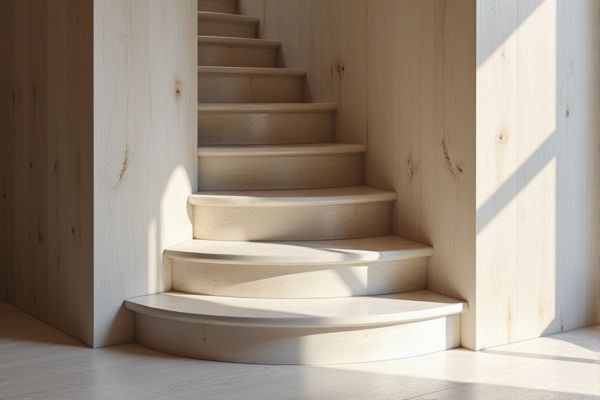
Choosing between a floating step and a solid step depends on your specific needs for stability and design preference; floating steps offer a modern, airy aesthetic with open risers, while solid steps provide enhanced durability and a traditional, sturdy feel. Explore the rest of the article to determine which option best suits your staircase project and lifestyle requirements.
Table of Comparison
| Feature | Floating Step | Solid Step |
|---|---|---|
| Definition | Isolated, individual step not connected to structure. | Continuous, rigid step integrated into building framework. |
| Material | Often wood, metal, or glass with supports. | Concrete, stone, or solid wood. |
| Installation | Suspended or cantilevered from wall or beam. | Fixed directly within floor or stair assembly. |
| Aesthetics | Modern, minimalist, open appearance. | Traditional, sturdy, solid look. |
| Structural Support | Requires strong anchoring and hidden supports. | Self-supporting through mass and connection. |
| Safety | May lack handrails; perceived risk higher. | Usually includes handrails; stable and safe. |
| Cost | Typically higher due to custom fabrication. | Generally lower; traditional construction methods. |
| Applications | Modern homes, stylish interiors. | Residential, commercial, industrial buildings. |
Introduction to Floating Steps vs Solid Steps
Floating steps feature open risers and are anchored to a wall or stringer, creating a visually lightweight, modern look that allows light to flow through the staircase. Solid steps, by contrast, have closed risers and a continuous structure that provides a traditional, sturdy appearance with greater sound insulation and structural solidity. The choice between floating and solid steps impacts both aesthetic appeal and space perception in architectural design.
What Are Floating Steps?
Floating steps are stair treads that appear to be suspended without visible support, creating an open and modern aesthetic by using hidden stringers or brackets. Unlike solid steps, which rest on a continuous solid structure, floating steps provide a minimalist design and allow more light to pass through your staircase area. These stairs enhance space perception and add a contemporary architectural element to your home or office interior.
What Are Solid Steps?
Solid steps are traditional stair steps securely anchored to a supporting structure, typically made from wood, concrete, or metal, providing a stable and durable surface for walking. Unlike floating steps, which appear to hover without visible supports, solid steps offer enhanced safety and structural integrity due to their continuous attachment. These steps are ideal for applications requiring maximum strength and support, ensuring your staircase remains robust and reliable over time.
Key Design Differences
Floating steps feature open risers and are supported by concealed brackets or side stringers, creating a lightweight, airy appearance ideal for modern interiors. Solid steps, constructed with closed risers and robust stringers, provide a more traditional, sturdy structure offering sound insulation and enhanced safety. The primary design difference lies in floating steps emphasizing minimalistic aesthetics and transparency, while solid steps prioritize durability and classic form.
Structural Strength and Stability
Floating steps offer a modern aesthetic with minimalist design but generally provide less structural strength and stability compared to solid steps, which are firmly anchored and built to support heavier loads. Solid steps distribute weight more uniformly and resist lateral movement, making them ideal for high-traffic or outdoor areas prone to dynamic forces. Your choice should consider the balance between desired appearance and the necessity for robust structural performance.
Aesthetic Appeal and Flexibility
Floating steps enhance aesthetic appeal by creating an open, minimalist look that visually expands space and allows light to flow freely. Solid steps offer greater flexibility in design, accommodating various materials, shapes, and finishes to match diverse architectural styles. The choice between floating and solid steps depends on the desired balance between modern elegance and customizable practicality.
Installation Processes Compared
Floating steps typically feature a simpler installation process requiring minimal structural alterations; they are often installed using brackets anchored to the wall, allowing for easier adjustments and faster setup. Solid steps demand more extensive groundwork and framing, involving precise measurements, securing support to the floor, and potentially reinforcing underlying structures for stability. The floating step installation emphasizes reduced material use and quicker assembly, while solid steps prioritize durability with a more labor-intensive approach.
Maintenance and Durability
Floating steps require less maintenance since they allow for natural expansion and contraction, reducing the risk of warping or cracking. Solid steps offer superior durability due to their continuous material structure, providing long-lasting support and resistance to heavy wear. Choosing the right option depends on environmental exposure and usage frequency to optimize longevity and upkeep efforts.
Cost Analysis: Floating vs Solid Steps
Floating steps generally incur higher labor and installation costs due to the complexity of attaching treads securely to a wall or stringer without visible supports. Solid steps, often constructed from a single material like concrete, wood, or stone, tend to have lower upfront costs and require less specialized labor. Maintenance expenses can vary, with floating steps potentially needing more frequent inspections to ensure stability, impacting long-term cost considerations.
Choosing the Right Staircase for Your Space
Floating steps create an open, modern aesthetic by anchoring treads directly to the wall without visible supports, enhancing light flow and spatial perception. Solid steps offer durability and traditional stability with fully supported risers and treads, ideal for high-traffic areas or where safety is paramount. Selecting between floating and solid steps depends on space size, design preferences, and structural requirements to ensure functionality and visual harmony.
 homyna.com
homyna.com